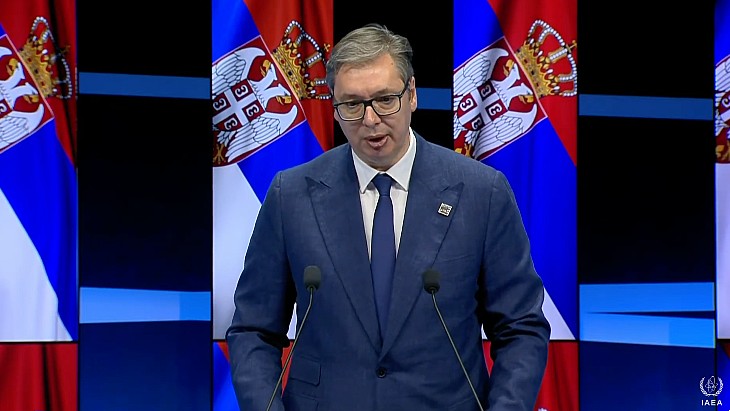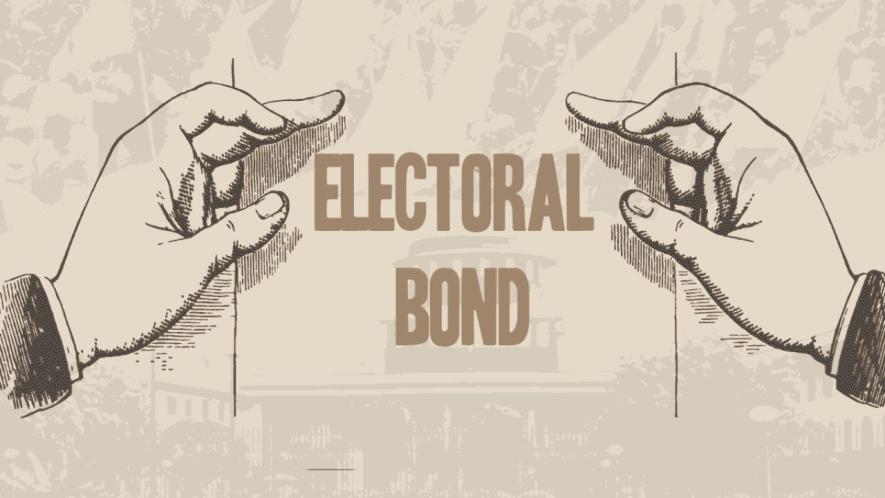NUCLEAR POWER
Chamber calls for Western Australia to overturn uranium ban
26 March 2024
Restarting uranium mining in Western Australia could create up to 9000 jobs and produce uranium worth more than AUD1 billion a year, a 12-month inquiry by the state's Chamber of Commerce and Industry has found. It recommends that the state overturn its ban on uranium mining to unlock significant economic benefits.
.jpg?ext=.jpg) Yeelirrie: one of four uranium projects excluded from the ban (Image: Cameco Australia)
Yeelirrie: one of four uranium projects excluded from the ban (Image: Cameco Australia)Western Australia is home to a "considerable share" of Australia's uranium but cannot capitalise on this, due to the state government's 2017 ban on uranium mining, the Chamber of Commerce and Industry of Western Australia (CCIWA) notes in its report. The ban conditionally excludes four uranium projects that had already received ministerial approval from the previous government: Wiluna, Kintyre, Mulga Rock and Yeelirrie.
South Australia and the Northern Territory currently allow uranium to be mined and exported, proving the industry is safe and sustainable, the CCIWA said. Last year South Australia produced around 5,469 tU: Western Australia has capacity to produce an estimated 8,000 tonnes per year, it added.
Other Australian states have been able to capitalise on increasing uranium demand and prices that have "skyrocketed" over the past year or so because of a global shift towards nuclear power in countries like China, France, India, Japan, South Korea, the United States and the UK, CCIWA Chief Economist Aaron Morey said. "WA has the technical skills and know-how to reignite the uranium mining industry as well as the export infrastructure to get it to market," he added.
He also said attitudes were changing thanks to advances in technology and an understanding of the role nuclear energy could play in reducing global emissions. "The ban on new uranium mines in WA was driven by environmental, health and safety concerns, but these concerns are not significantly different to those faced by any mining operation. WA is a mining state with a reputation for safety and world's best practice. We have a strong regulatory framework, existing infrastructure and all the skills needed to safely mine and export uranium," he added, noting that uranium exports are also bound by Australian legislation to ensure they are only used for energy production and not in the development of nuclear weapons. "If South Australia and the Northern Territory can do it, there's no reason why WA can't."
Citing last year's COP28 Summit, where 22 countries signed a ministerial declaration recognising the need to triple global nuclear energy by 2050, Morey said uranium demand will continue to be high, while "supply constraints look set to worsen". Allowing uranium mining in Western Australia would harness an opportunity to supply to countries already using nuclear power, he said, adding "If they don't buy uranium from WA, they'll simply buy it elsewhere".
Work to expand Dutch enrichment plant begins
26 March 2024
Uranium enrichment services provider Urenco has broken ground on an expansion of its plant in Almelo in the Netherlands. The move came as the company signed a new long-term supply contract with Korea Hydro & Nuclear Power.
.jpg?ext=.jpg) The ceremony to launch the expansion work at Almelo (Image: Urenco)
The ceremony to launch the expansion work at Almelo (Image: Urenco)
Urenco announced plans in December last year to increase capacity at its Almelo plant by 15% in response to new commitments from customers. The project will see multiple new centrifuge cascades added to an existing plant at the site, adding about 750 tonnes of SWU per year. The first new cascades are scheduled to come online around 2027.
A ceremony was held on 25 March to mark the start of work on the capacity expansion at Almelo.
This is the third major investment to be approved under Urenco's capacity programme to strengthen the nuclear fuel supply chain worldwide. Earlier in 2023, Urenco approved its first expansion project at its plant in Eunice, New Mexico - the only operating commercial uranium enrichment facility in North America - providing an additional capacity of 700 tonnes of SWU per year. The first new cascades are due online in 2025. The plant currently has a production capacity of 4600 tSWU per year.
At its site in Gronau, Germany, the company is re-fitting an existing space with more modern centrifuge technology which will enhance the capacity of the plant.
"Urenco takes the needs of the market incredibly seriously," said Urenco Almelo Managing Director Ad Louter. "This project will help deliver 1.6 million SWU in total alongside other projects happening at our sites in Germany and the USA. Energy security and decarbonisation have never been so important as they are today, and we are in a time of great change for nuclear without which it will be impossible to meet ambitious climate targets."
Urenco said its capacity programme "is a mid to long-term plan to refurbish and extend" enrichment capacity at all four of its sites. "It comes as more countries and utility companies turn to nuclear for the first time, or seek to extend and/or diversify fuel supplies for existing nuclear operations," it added.
Korean contract
Urenco announced it has signed a new contract for the long-term supply of enrichment services with Korea Hydro & Nuclear Power (KHNP), operator of South Korea's nuclear power plants, which generate more than 34% of the country's total electricity.
.jpg)
The signing of the contract (Image: Urenco)
A contract signing ceremony took place in Brussels on 22 March, with KHNP's President and CEO Jooho Whang and Urenco's Chief Commercial Officer Laurent Odeh.
Urenco has been supplying enriched uranium to KHNP since 1993. It said the new contract "will further improve long-term fuel supply stability".
"KHNP aims to build a number of new nuclear power plants at home and abroad, and cooperation with reliable partners such as Urenco will be very important as demand for nuclear power increases internationally," Whang said.
"We are delighted to reaffirm our strong working relationship with KHNP and look forward to playing our part in helping to achieve its energy vision for Korea - as well as contributing to its climate change goals," Laurent said. "Urenco is committed to meeting increased demand for enrichment services with flexible, resilient and sustainable operations."
Serbian president's appeal as country targets four SMRs
26 March 2024
Serbia is seeking support from other countries on nuclear know-how and financing towards its goal of getting 1200 MW of capacity from small modular reactors, President Aleksandar Vučić told the Nuclear Energy Summit.
 President Vučić, speaking at the event in Brussels (Image: Screengrab from IAEA live feed)
President Vučić, speaking at the event in Brussels (Image: Screengrab from IAEA live feed)
Vučić noted that since the break up of the former Yugoslavia, Serbia has not had any experience of nuclear energy, and he welcomed the summit as a chance "to discuss big plans, big things for the future but we don't know how to implement it".
Arriving for the summit he said: "Today it is important that we understand how far behind we are and how we made wrong decisions in the previous 35 and 40 years. The importance attached to this summit indicates to us how much electricity we will lack in the future. To simplify it - without nuclear energy we we will not be able to survive the arrival of artificial intelligence or electric cars."
And addressing fellow leaders and government representatives, he said: "We have three problems. Number one, is that we don't have know-how about the use of nuclear energy and we don't know exactly where to get it. Number two is how are we going to finance all these projects. And I can tell you in advance, that we are very much interested in getting at least four SMRs (small modular reactors) that can replace 1200 megawatts.
"We don't know how to do it, how to finance it, because it costs about EUR7.5 billion up to EUR 8 billion (USD8.7 billion). Anyway, we are ready to participate significantly but we need to have some sort of support from leading countries of the European Union.
"Number three, it means that we also need to get a change of mindset for our people, which is not easy, but we are ready to do it, which means we'll not only adjust, but will have to change, the overall legislative framework, and we'll do it."
The reference to the need for law changes being required is because the construction of nuclear power plants, nuclear fuel production plants and plants for used nuclear fuel processing for nuclear power plants has been forbidden since 1989, predating the breakup of the former Yugoslavia.
He added that he would "like to get a lot of help, particularly know-how for my country" and invited the summit co-host, International Atomic Energy Agency Director General Rafael Mariano Grossi, to visit Belgrade "as soon as possible".
Nuclear medicine
The Nuclear Energy Summit, held in Belgium on 21 March, has been followed this week by the Atomexpo event in Sochi, Russia, with Rosatom Health Technologies and Serbia's health ministry concluding a memorandum of understanding on cooperation in the field of nuclear medicine.
Agreements with Burkina Faso, Nicaragua and Kazakhstan at Atomexpo
26 March 2024
Russia's Rosatom has signed agreements relating to developing nuclear medicine centres in Nicaragua and Kazakhstan, and also a memorandum of understanding with Burkina Faso which includes potential nuclear energy projects.
 Atomexpo was first held in 2009 (Image: Rosatom)
Atomexpo was first held in 2009 (Image: Rosatom)
The agreements were signed at the Atomexpo 2024 international forum, which is currently taking place in Sochi.
Rosatom Director General Alexei Likhachev and Burkina Faso's Energy Minister Yacouba Zabre Guba signed a roadmap which "outlines concrete steps for both sides to build the West African country's peaceful nuclear workforce, develop nuclear infrastructure and create a positive public opinion regarding nuclear energy in Burkina Faso. Based on the results of the formation of an international legal framework for cooperation, the parties intend to work on the issue of implementing nuclear generation projects and non-energy applications of radiation technologies in agriculture and medicine in Burkina Faso".
The roadmap signed by Rosatom Health Technologies Director General Igor Obrubov and Nicaragua's Health Minister Oscar Vazquez, covered a joint project to build a nuclear medicine centre, specialising in the diagnosis and treatment of patients, in particular those with cancer, and also covers cooperation in health worker training.
Vazquez said: "Rosatom’s competence in creating specialised medical infrastructure facilities gives every reason to be confident in the effective implementation of our joint project ... (and) will allow us to reach a qualitatively new level in the diagnosis and treatment of socially significant diseases and expand access to modern nuclear medicine technologies for doctors and patients in Nicaragua."
Obrubov said Rosatom's activities "include the production of isotopes and the production of radiopharmaceuticals, the development and production of high-tech medical equipment, and the construction of medical infrastructure facilities. We are pleased to assist citizens of the Republic of Nicaragua".
Obrubov also signed a memorandum of understanding alongside Zhanar Ospanova, Health Minister of the Zhambyl region of Kazakhstan to implement joint projects relating to the development of nuclear medicine.
Ospanova said: "Given that Rosatom has significant experience and competencies in implementing projects in the field of nuclear medicine, I am confident that our joint work will make significant progress in the diagnosis and treatment of socially significant diseases, in particular oncology. This interaction has the most important goal - to expand access for doctors and patients to the most modern technologies to preserve and improve health."
This year's Atomexpo is the 13th staging of the business and exhibition event, which is supported by Russia's state nuclear corporation Rosatom.
Laser enrichment company declines HALEU opportunity, moves forward with testing
26 March 2024
Global Laser Enrichment has decided not to submit a proposal in response to a US Department of Energy request for the acquisition of high-assay low-enriched uranium enrichment, its 51%-owner Silex Systems has announced. The company has also received regulatory approval to load uranium hexafluoride for the start of testing to demonstrate the technology it plans to use in its enrichment facility at Paducah in Kentucky.
.jpg?ext=.jpg) The Paducah site when it was the home of a gaseous diffusion enrichment plant (Image: US DOE)
The Paducah site when it was the home of a gaseous diffusion enrichment plant (Image: US DOE)
In January, the Department of Energy (DOE) issued a Request for Proposals (RFP) for uranium enrichment services to help establish a reliable domestic supply of fuels using high-assay low-enriched uranium, or HALEU. Enriched to between 5% and 20% U-235, HALEU fuel is used by many of the advanced reactor designs that are currently under development, but is not currently commercially available from US-based suppliers.
Global Laser Enrichment LLC (GLE) is the exclusive global licensee of the SILEX laser-based uranium enrichment technology which was originally developed by Australian company Silex. It is 49%-owned by Canadian company Cameco, which is the commercial lead for the GLE project and holds an option to attain a majority interest of 75%.
GLE is working towards demonstration of the SILEX technology at its Test Loop pilot facility in Wilmington, North Carolina. It is also progressing activities to commercial-scale deployment at the Paducah Laser Enrichment Facility (PLEF), which is underpinned by a 2016 agreement for the sale to GLE of some 200,000 tonnes of depleted uranium hexafluoride from the DOE to provide feedstock for the production of natural UF6.
In addition to the production of natural grade UF6 (containing 0.7% uranium-235) from the processing of depleted uranium, the multipurpose plant has two further commercialisation options: the production of enriched uranium from natural UF6 to supply enriched uranium fuel for existing reactors; and the production of HALEU.
According to Silex, GLE's evaluation has determined that the RFP "does not warrant GLE changing from its first commercial priority" of producing natural UF6. This would seem to be in line with Cameco's latest Management’s discussion and analysis (MD&A) document, published in February, in which the company said "our view is that re-enriching US government inventories of depleted uranium tails into a commercial source of uranium and conversion is GLE's lowest-risk path to the market", adding that the agreement with the DOE to upgrade depleted uranium tails left over from historic enrichment operations "may help address the growing supply gap for Western nuclear fuel supplies and services" - PLEF's planned annual output of up to 5 million pounds of U3O8 (1923 tU) would place it in the top ten global uranium mines in terms of production volumes.
GLE is "currently awaiting details" on a potential USD100 million funding opportunity from DOE to support novel enrichment technology, which is expected to be published this year, Silex said. It also noted that the US Consolidated Appropriations Act 2024, which has now been signed into law, includes USD2.7 billion of funding - contingent on a US government ban on imports of nuclear fuel from Russia - which is expected to provide support for production of both low-enriched uranium and HALEU.
"We continue to encourage the DOE to move expeditiously to publish all available funding opportunities to create a competitive, diverse US fuel supply chain and to enable the cessation of reliance on Russian-sourced nuclear fuel," Silex said.
Technology readiness testing go-ahead
Separately, Silex has announced that the US Nuclear Regulatory Commission (NRC) has completed an inspection of GLE's Test Loop pilot demonstration facility and operational safety programmes in Wilmington, North Carolina, providing the approval for GLE to load UF6 feed material in preparation for the start of TRL-6 enrichment testing.
TRL-6 is the sixth of nine internationally recognised technology readiness levels used to assess the maturity of a technology. TRL-6 confirms large-scale system performance under relevant conditions (pilot-scale demonstration).
The NRC review and approval of the Test Loop facility and operations clears the way for the final preparations for TRL-6 enrichment testing, which is expected to begin in the second quarter of this year, Silex said. GLE anticipates completing the technology demonstration project this year. "Subject to the successful completion of the TRL-6 pilot demonstration project, industry and government support, a feasibility assessment for the Paducah Laser Enrichment Facility, suitable market conditions, and other factors, this preserves the option to commence commercial operations at the planned PLEF in Kentucky as early as 2028," the company added.
Researched and written by World Nuclear News



.jpg?ext=.jpg) Yeelirrie: one of four uranium projects excluded from the ban (Image: Cameco Australia)
Yeelirrie: one of four uranium projects excluded from the ban (Image: Cameco Australia).jpg?ext=.jpg) The ceremony to launch the expansion work at Almelo (Image: Urenco)
The ceremony to launch the expansion work at Almelo (Image: Urenco).jpg)
 President Vučić, speaking at the event in Brussels (Image: Screengrab from IAEA live feed)
President Vučić, speaking at the event in Brussels (Image: Screengrab from IAEA live feed) Atomexpo was first held in 2009 (Image: Rosatom)
Atomexpo was first held in 2009 (Image: Rosatom).jpg?ext=.jpg) The Paducah site when it was the home of a gaseous diffusion enrichment plant (Image: US DOE)
The Paducah site when it was the home of a gaseous diffusion enrichment plant (Image: US DOE)

